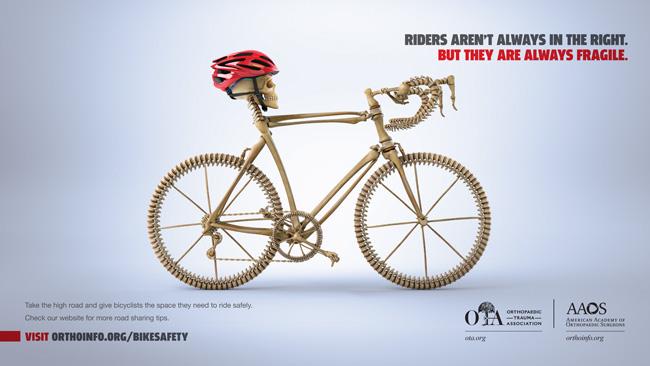Staying Healthy
Bicycle Safety
More than 80 million people in the United States have taken up bicycling for fun, exercise, and transportation.
According to the National Safety Council (NSC), in 2020, there were more than 325,000 preventable bike-related injuries in the U.S.
Common Bicycle Injuries
Bruises and minor cuts are usually the leading types of injuries involving bicycles, followed by fractures, muscle strains, and sprains. However, serious injuries, including death, do occur. According to the NSC, there were nearly 1,260 preventable bicycle-related deaths in 2020.
Some of the most common cycling injuries that orthopaedic surgeons treat include broken collarbones and wrist fractures (scaphoid or distal radius).
Tips for Preventing Injuries
To minimize your risk of injury while riding a bicycle:
- Wear a helmet. Studies show that wearing a bike helmet reduces your risk of a serious head injury by nearly 70% and of a fatal head injury by 65%. Always wear a helmet approved by the American National Standards Institute.
- Make sure the helmet fits snugly but comfortably and does not block your vision.
- It should have a chin strap and buckles that stay securely fastened.
- Follow the rules of the road.
- Familiarize yourself with all of the bicycle rules of the road in your city or state.
- Ride in the direction of traffic.
- Follow traffic signs and lights.
- Signal your turns or your intentions so that drivers can anticipate your actions.
- If you are riding with others, ride single file.
- Ride defensively.
- Understand that drivers often do not see cyclists, so you must be fully aware of your surroundings and ready to act to avoid a collision. Intersections are especially dangerous because drivers making turns are not necessarily looking for cyclists.
- Be careful when riding next to parked cars to avoid being hit by an opening door.
- Watch for cars pulling out of alleys, parking lots, and garages.
- Choose bike routes wisely.
- Avoid riding on high traffic roads. The most direct route to your destination is often not the safest because more vehicles will also take that route. Select streets with fewer and slower cars.
- Whenever possible, choose streets with designated bicycle lanes. If there is not a bicycle lane, ride on the right shoulder of the road.
- Choose wide streets. When a street lane is too narrow for a vehicle and bicycle to safely ride side-by-side, or if there are several parked cars on the street, you will need to join traffic and ride toward the center of the road. If this causes traffic behind you to jam, or if cars are switching lanes trying to pass you, it is safest to find a different, quieter street.
- Avoid distracted cycling. Do not listen to loud music with headphones, talk on your phone, text, or do anything else that can obstruct your hearing and/or vision while riding.
- Take extra precautions while bicycling at night. Wear bright fluorescent colors and make sure to have rear reflectors. Both a working taillight and headlight should be visible from 500 feet away.
- Say no to drugs and alcohol. Just as you should never drive a car while under the influence, don't ride a bicycle after consuming recreational drugs or alcohol. Also avoid getting on a bike if you are taking prescription or over-the-counter medications that cause drowsiness or confusion.
- Never underestimate road conditions. Be cautious of uneven or slippery surfaces. Be on the lookout for potholes, rocks, animals, and other obstacles that may cause you to swerve or crash.
- Maintain your bicycle. Check your bicycle's mechanical components on a regular basis (brakes, tires, gears, etc.), just like you would for a car. If your bike is not in good condition, do not ride it.
- Adjust your bicycle to fit. Make certain the bicycle is the proper size for the rider. Appropriately sized frames, handlebar, and seat heights will improve your ability to control the bike and reduce the risk for overuse injuries. If you ride regularly, consider a professional fit from a bike shop.
- Dress appropriately.
- Avoid loose clothing
- Wear appropriate footwear. Never wear flip flops or clogs. Avoid shoes that are too large and might fall off your feet.
- Wear padded gloves.
- Use appropriately padded cycling shorts for longer rides.
- Wear sunscreen.
- If you commute on your bike, carry your belongings in a bag with close fitting straps.
- Pace yourself. Cycling can be vigorous exercise. Make sure you are fit enough to participate before you start pedaling. In addition, make sure you understand how to use the gear systems on your bike to help control your physical exertion level. See your doctor before you begin any exercise program.
- Change riding positions. Slight variations in your position can reduce stress on pressure points on your body and avoid overstressing muscles.
- Hydrate. Be sure to carry water and food on longer rides. Drink a full water bottle each hour you spend on the bike.
- Supervise younger riders at all times. It is recommended that younger children ride only in enclosed areas — away from moving vehicles and traffic.
Last Reviewed
August 2022
Contributed and/or Updated by
Peer-Reviewed by
AAOS does not endorse any treatments, procedures, products, or physicians referenced herein. This information is provided as an educational service and is not intended to serve as medical advice. Anyone seeking specific orthopaedic advice or assistance should consult his or her orthopaedic surgeon, or locate one in your area through the AAOS Find an Orthopaedist program on this website.








